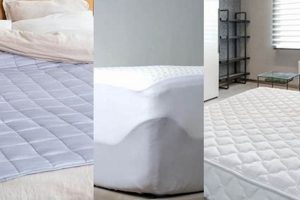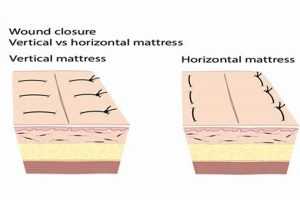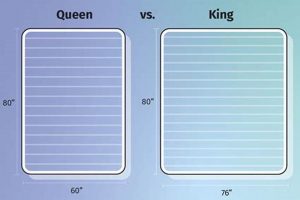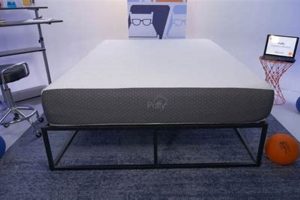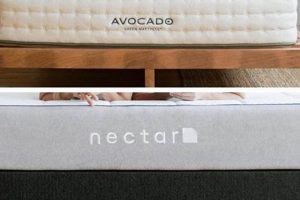The central consideration involves a choice between a supplementary layer designed to enhance an existing sleep surface and a complete replacement of that surface. This decision point often arises when individuals seek to improve sleep quality or address discomfort experienced with their current bedding arrangement. For instance, a person might consider adding padding to a firm bed as an alternative to discarding the entire unit and procuring a softer model.
The significance of this determination lies in its impact on both sleep health and financial expenditure. A judicious selection can lead to improved spinal alignment, pressure relief, and overall restfulness. Historically, individuals faced with uncomfortable beds had limited options; however, advancements in materials and manufacturing have broadened the range of available solutions, allowing for more nuanced adjustments to the sleep environment. The economic ramifications are also considerable, with the cost of a new sleeping platform significantly exceeding the expense of an additive layer.
Therefore, a detailed examination of factors such as current mattress condition, desired level of comfort adjustment, budget constraints, and long-term sleep goals is essential. A thorough comparison of these elements will facilitate a well-informed decision regarding the most appropriate course of action for optimizing sleep quality and overall well-being. The subsequent discussion will delve into the specific advantages and disadvantages of each option.
Guidance on Mattress Enhancement or Replacement
This section offers objective advice to assist in the decision-making process regarding improvements to sleep surfaces. The following points should be considered before selecting between an additional layer and a complete sleeping platform replacement.
Tip 1: Assess the Existing Mattress Condition: Evaluate the current sleeping surface for signs of wear. If the mattress exhibits significant sagging, deep impressions, or broken springs, an additional layer may offer only a temporary or inadequate solution. A fundamentally compromised sleeping platform requires replacement.
Tip 2: Define Desired Comfort Level: Determine the specific comfort characteristics sought. If the goal is to slightly soften a firm bed or add a layer of pressure relief, an additional layer might suffice. However, a substantial change in firmness or support often necessitates a new mattress.
Tip 3: Establish a Budget: Consider the financial constraints. Additional layers typically represent a less expensive alternative to complete replacement. If budget is a primary concern, explore the range of available options within the allocated funds for both choices.
Tip 4: Evaluate Long-Term Sleep Goals: Consider future sleep needs and potential changes in health conditions. If significant shifts in support requirements are anticipated, investing in a new sleeping platform that can accommodate those changes may be prudent.
Tip 5: Research Material Options: Investigate the various materials available for both supplemental layers and entire sleeping platforms. Different materials offer distinct characteristics in terms of temperature regulation, support, and durability. Informed selection based on individual needs is essential.
Tip 6: Consider Trial Periods and Warranties: Inquire about trial periods and warranties offered for both supplemental layers and complete replacements. A trial period allows for assessment of comfort and suitability, while a warranty provides protection against manufacturing defects.
Tip 7: Seek Professional Advice: Consult with sleep specialists or knowledgeable retail staff to obtain personalized recommendations based on individual sleep habits and preferences. Professional guidance can provide valuable insights and ensure a well-informed decision.
Careful consideration of these points will facilitate a reasoned decision, ensuring a sleep environment conducive to restful and restorative sleep. Making an informed decision provides significant benefits.
The subsequent section will offer a concluding perspective, summarizing the key considerations for optimal sleep surface selection.
1. Existing Mattress Condition
The state of the current sleep surface is a primary determinant in the decision-making process. A careful evaluation of its condition directly influences whether a supplementary layer provides a suitable solution or a full replacement becomes necessary.
- Sagging and Indentations
Significant sagging or deep body impressions indicate a breakdown of the internal support structure. In such cases, a supplementary layer will conform to the existing contours, failing to provide uniform support and potentially exacerbating alignment issues. For instance, a mattress with pronounced sagging in the center will not be adequately corrected by a topper, resulting in continued discomfort and compromised spinal health.
- Spring or Core Deterioration
Audible noises from springs, or a palpable lack of resilience in foam cores, signal significant wear. A supplementary layer cannot compensate for compromised internal components. The underlying structural deficiencies will continue to affect sleep quality, regardless of the added comfort layer. Replacement is necessary to address these fundamental issues.
- Surface Material Degradation
Tears, stains, or excessive wear on the surface fabric can impact hygiene and comfort. While a supplementary layer provides a superficial barrier, it does not address the underlying damage. Furthermore, degraded surface materials may contribute to allergen accumulation. Depending on the severity, hygiene concerns might necessitate a full mattress replacement.
- Age and Usage
The lifespan of a mattress is finite, typically ranging from seven to ten years, depending on material quality and usage. As mattresses age, materials degrade, leading to diminished support and comfort. While a topper can extend usability marginally, an aging mattress nearing the end of its lifespan generally benefits more from complete replacement, ensuring consistent support and hygiene.
In summary, assessing the existing sleeping platform determines the viability of supplemental layers. Significant structural or material compromise necessitates a full replacement to achieve optimal sleep quality and support. A topper is suitable only when the underlying sleeping surface is in relatively good condition and requires only a minor adjustment to comfort levels.
2. Desired Comfort Change
The magnitude and nature of the desired comfort adjustment serve as a crucial factor when deciding between a mattress topper and a complete mattress replacement. The level of alteration sought directly influences the suitability of each option. A minor adjustment, such as softening a slightly firm sleep surface, is often effectively achieved with a supplementary layer. This approach adds a thin layer of plushness or pressure relief without significantly altering the underlying support. Conversely, a substantial shift in comfort characteristicsfor example, transitioning from a very firm surface to a significantly softer one, or vice versatypically necessitates a full replacement. The existing mattress construction limits the degree to which a topper can alter the overall feel. Attempting to achieve a dramatic change with a topper may result in inadequate support or an uneven sleep surface, leading to compromised sleep quality. Consider a person with chronic back pain seeking a softer surface to alleviate pressure points; a topper on an old, unsupportive mattress may only offer temporary relief, while a new mattress designed for pressure relief and spinal alignment provides a more comprehensive solution.
Understanding the limitations of mattress toppers is paramount. While these can effectively address minor comfort preferences, they are not designed to correct fundamental support deficiencies or dramatically alter the overall firmness profile. For instance, individuals seeking to address significant sagging or unevenness within the current mattress should recognize that a topper will simply conform to the existing contours, potentially exacerbating the problem. Therefore, a careful evaluation of the specific comfort issues being addressed, as well as the magnitude of the desired change, is essential in determining the appropriate course of action. Another instance might be someone desiring increased support due to changes in body weight or sleeping habits; a thicker, firmer mattress is typically more effective than any supplemental layer at providing lasting, consistent support.
In summary, desired comfort change is a critical determinant in the mattress topper versus new mattress decision. Minor adjustments in surface feel often warrant a topper, while significant shifts in comfort or support needs typically necessitate a complete replacement. Ignoring the magnitude of desired comfort change can lead to a suboptimal sleep environment and continued discomfort. Therefore, a thorough assessment of comfort requirements is essential for making an informed decision that promotes restful sleep and overall well-being. Making an informed decision based on the right analysis allows for great benefit to the end-user.
3. Budgetary Constraints
The financial resources available directly influence the decision between a mattress topper and a new mattress. Limited financial means often steer individuals toward a topper as a more immediate and affordable solution. This choice becomes particularly relevant when the primary concern involves a slight improvement in comfort or a temporary extension of the current mattress’s lifespan. The financial outlay for a topper is significantly less than that required for a new, quality sleeping platform. For instance, an individual on a fixed income experiencing slight discomfort might opt for a memory foam topper to alleviate pressure points, postponing the larger investment of a mattress replacement.
However, relying solely on budgetary constraints without considering the underlying condition of the existing mattress or long-term sleep needs can lead to suboptimal outcomes. If the existing mattress exhibits significant sagging or internal damage, a topper will provide only a superficial improvement. In such cases, the initial cost savings of a topper may be offset by the continued discomfort and the eventual necessity of replacing the mattress sooner than anticipated. A more fiscally responsible approach involves a thorough assessment of the existing mattress and a realistic evaluation of long-term sleep health. Exploring financing options or setting aside funds for a higher-quality mattress that addresses long-term needs represents a more strategic use of resources, even if it requires a longer period of saving.
In summary, budgetary constraints serve as a critical factor, yet they should not be the sole determinant. While a topper offers an immediate and less expensive solution, a comprehensive evaluation of the mattress’s condition and long-term sleep requirements ensures a more economically sound and health-conscious decision. Addressing the root cause of sleep discomfort, even if it requires a more significant upfront investment, typically yields better results and ultimately proves more cost-effective over the long term. Failing to acknowledge the underlying issues in favor of a cheaper, temporary solution can often lead to recurring costs and prolonged discomfort, thus negating any perceived financial advantage.
4. Long-Term Needs
The anticipation of future changes in health status, body weight, or sleep habits represents a critical dimension when evaluating supplemental sleep surfaces versus total replacement. A mattress topper offers a short-term solution for existing comfort issues, but fails to address evolving support requirements. For instance, an individual anticipating pregnancy may experience significant changes in weight distribution and spinal alignment. A temporary topper may not provide adequate support throughout the pregnancy and postpartum period, whereas a new mattress designed with adjustable support or enhanced pressure relief proves a more adaptable long-term investment. Similarly, individuals with progressive medical conditions, such as arthritis or scoliosis, require sleeping platforms that can accommodate changing support needs as their conditions evolve. A new mattress provides the opportunity to select materials and construction features specifically tailored to manage evolving discomfort and maintain optimal spinal alignment over an extended period.
The implications of neglecting long-term needs extend beyond mere discomfort. Inadequate support over time can exacerbate existing health conditions, leading to increased pain, reduced mobility, and diminished quality of life. Conversely, investing in a sleeping platform designed to accommodate future changes promotes proactive health management. Consider an aging individual with osteoporosis. A mattress topper can provide temporary cushioning, but it fails to address the underlying need for consistent support that minimizes pressure on vulnerable joints. A new mattress engineered with targeted support zones and pressure-relieving materials can significantly reduce pain and improve sleep quality, contributing to overall well-being and independence in the long term. The initial investment in a quality sleeping surface proves a preventive measure, mitigating the potential for more costly medical interventions later in life.
In conclusion, the consideration of long-term needs serves as a crucial element in the mattress topper versus new mattress decision. While budgetary constraints and immediate comfort concerns often dominate the decision-making process, neglecting future support requirements can lead to suboptimal outcomes and compromised health. A forward-thinking approach that prioritizes adaptability and addresses anticipated changes proves a more prudent investment, ensuring sustained comfort, support, and overall well-being over an extended period. Prioritizing the right solutions today ensures the best experience in the future.
5. Material Properties
The selection between a supplementary sleep surface layer and a full replacement heavily depends on the properties of the materials employed in both options. Material characteristics dictate comfort, support, temperature regulation, durability, and allergenicity, influencing the suitability of each choice based on individual needs and preferences.
- Density and Support Characteristics
Density affects both the conforming ability and the support provided. High-density memory foam conforms closely to the body, offering pressure relief, while high-density latex provides a more resilient support. When considering a supplemental layer, the density must complement the existing mattress. Placing a high-density topper on a sagging mattress provides inadequate support. Conversely, a low-density topper on a firm mattress might offer insufficient pressure relief. Material density influences the overall feel and support, impacting spinal alignment and sleep quality. Material density ensures quality.
- Thermal Regulation Capabilities
Materials exhibit varying degrees of breathability and heat retention. Memory foam tends to retain heat, potentially causing discomfort for warm sleepers, whereas latex and materials with open-cell structures promote airflow and dissipation of heat. Topper selection should consider individual thermoregulation needs. A cooling gel-infused topper might benefit a warm sleeper with a heat-retaining mattress. However, a new mattress incorporating breathable materials provides a more comprehensive solution to temperature regulation, impacting the overall quality of sleep, including how the mattress manages temperature and moisture.
- Durability and Longevity
Material composition affects the lifespan of both toppers and mattresses. High-quality latex and high-density foams exhibit greater resistance to compression and degradation compared to lower-density alternatives. A low-quality topper may compress and lose its supportive properties within a short period, rendering it ineffective. A well-constructed mattress using durable materials offers sustained support and comfort over an extended lifespan. Durability should be a primary focus in the decision-making process and is always a key differentiator.
- Allergenicity and Hygiene
Some materials exhibit hypoallergenic properties, while others harbor allergens. Natural latex possesses inherent resistance to dust mites and mold, making it suitable for individuals with allergies. Conversely, some synthetic foams may require additional treatments to minimize allergen accumulation. If allergies are a concern, selecting a mattress or topper with hypoallergenic materials contributes to a cleaner sleep environment. Encasements and covers further enhance allergen protection, contributing to improved respiratory health during sleep and overall hygiene.
Understanding the properties of mattress materials influences the selection between supplemental sleep surface layers and full replacements. By considering density, thermal regulation, durability, and allergenicity, individuals can make informed decisions that promote optimal sleep comfort, support, and hygiene. Selecting the wrong material can lead to dissatisfaction and potentially exacerbate existing health concerns, underscoring the importance of material-based knowledge in this determination. Knowing the details will improve the sleep experience.
Frequently Asked Questions
The following section addresses common inquiries regarding the decision between a supplemental sleep surface layer and a complete mattress replacement. The responses aim to provide clarity and inform decision-making.
Question 1: When is a mattress topper an inappropriate solution?
A mattress topper is generally unsuitable when the existing sleeping platform exhibits significant sagging, structural damage, or is nearing the end of its expected lifespan. In such instances, a topper merely masks the underlying problem without providing adequate support or addressing hygiene concerns.
Question 2: How does one determine the correct topper thickness?
Topper thickness depends on the degree of desired comfort adjustment and individual body weight. Thicker toppers generally provide more cushioning, while thinner options offer a subtle change in surface feel. Consider body weight, as heavier individuals may require thicker toppers for adequate support.
Question 3: What are the primary differences between memory foam and latex toppers?
Memory foam conforms closely to the body, providing pressure relief and motion isolation. Latex offers a more resilient support with greater breathability. The choice depends on individual preferences regarding feel, temperature regulation, and responsiveness.
Question 4: Can a topper correct an excessively firm mattress?
A topper can soften a firm mattress, but the degree of change is limited. A thick, plush topper might provide noticeable relief, but the underlying firmness remains. Individuals seeking a significantly softer feel should consider a complete mattress replacement.
Question 5: How frequently should mattress toppers be replaced?
Topper lifespan depends on material quality and usage. High-density materials typically last longer. Signs of wear, such as compression or loss of support, indicate the need for replacement. A typical topper lasts one to three years.
Question 6: What role does body weight play in the selection of a mattress topper?
Body weight influences the amount of support and pressure relief provided by a topper. Heavier individuals require denser or thicker toppers to prevent bottoming out and ensure adequate spinal alignment. Lighter individuals may find thinner toppers sufficient.
These responses offer insight into essential considerations when weighing the option of a topper versus a new mattress. Careful assessment ensures optimal sleep health.
The subsequent section will provide a concluding summary, reinforcing critical decision-making factors.
Concluding Remarks
The preceding exploration has elucidated the critical considerations in determining whether a supplementary sleep surface layer or a complete mattress replacement constitutes the more appropriate solution. Factors such as the existing mattress condition, desired comfort change, budgetary constraints, long-term needs, and material properties each exert a substantial influence on the decision-making process. A comprehensive evaluation of these elements ensures a reasoned approach, minimizing the potential for dissatisfaction and maximizing the likelihood of achieving optimal sleep health.
Ultimately, the decision carries significant implications for individual well-being. Prioritizing a thorough assessment of both immediate and long-term needs is paramount. While budgetary limitations may necessitate compromises, failing to address underlying support requirements can result in recurring discomfort and diminished quality of life. The informed selection, whether it involves a cost-effective supplemental layer or a more substantial investment in a new sleeping platform, represents a critical step toward fostering restful sleep and promoting overall health.


